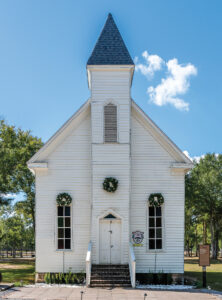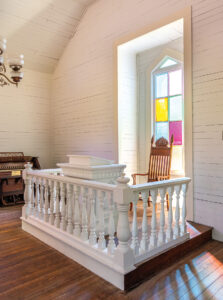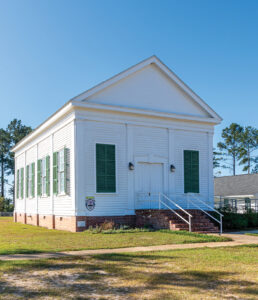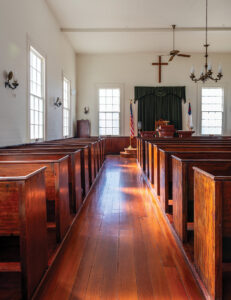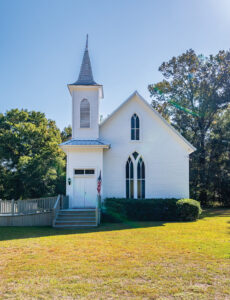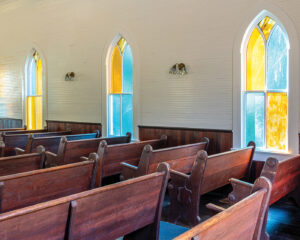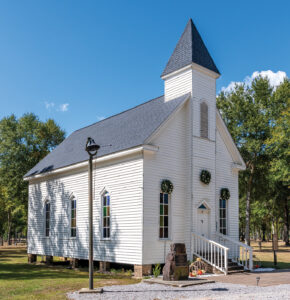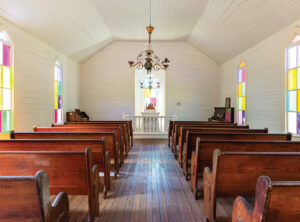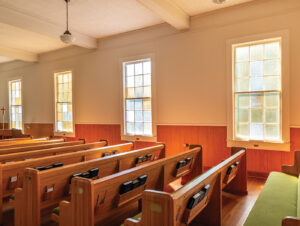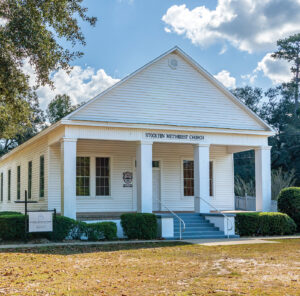Montpelier Methodist Church Once a church for only a few families, this chapel was abandoned in the 1970s until it was donated to a local park by its original owners in 2013. // Photos by Summer Ennis Ansley
Different hymns play in an old country church on Sunday afternoons. They can only be heard in the stillness of an empty sanctuary once the congregation leaves for after-church lunch. A ceiling fan hums and rocks its pull chain against its glass light shades. Choruses of cicadas and elegies of crows bleed through the lathe and plaster, echoing across heart pine floors. A pew cracks as it settles from the weight it bore during the liturgy. These doxologies still sound in the historic churches of the Mobile-Tensaw Delta, the notes hanging in colored light from the stained-glass windows with the dust stoked by the organist that morning. The chapels are now as they were in the beginning, their silhouettes and sweet austerity unaltered by the passage of time.
Remember the Days of Old
The Mobile-Tensaw River Delta is God’s country, as breathtaking and venerated now as it was when He created it. A woman traveling through the Delta by steamboat in 1884 insisted that it is even lovelier by moonlight, which she said transforms brackish streams into silvery veins and cypresses rooted in silt into specters. She found between expanses of trees and marshes, where she thought only alligators and waterfowl could survive, flickers of light from houses shrouded by mist. The physical distance between the residents of the Delta seemed insignificant when she joined them for their reading club. They had formed a small but refined community of hospitable agrarian scholars whose talents “would do credit in any literary society.” Their civility was a counter to the untamed landscape around them — raw creation balanced by gentility.
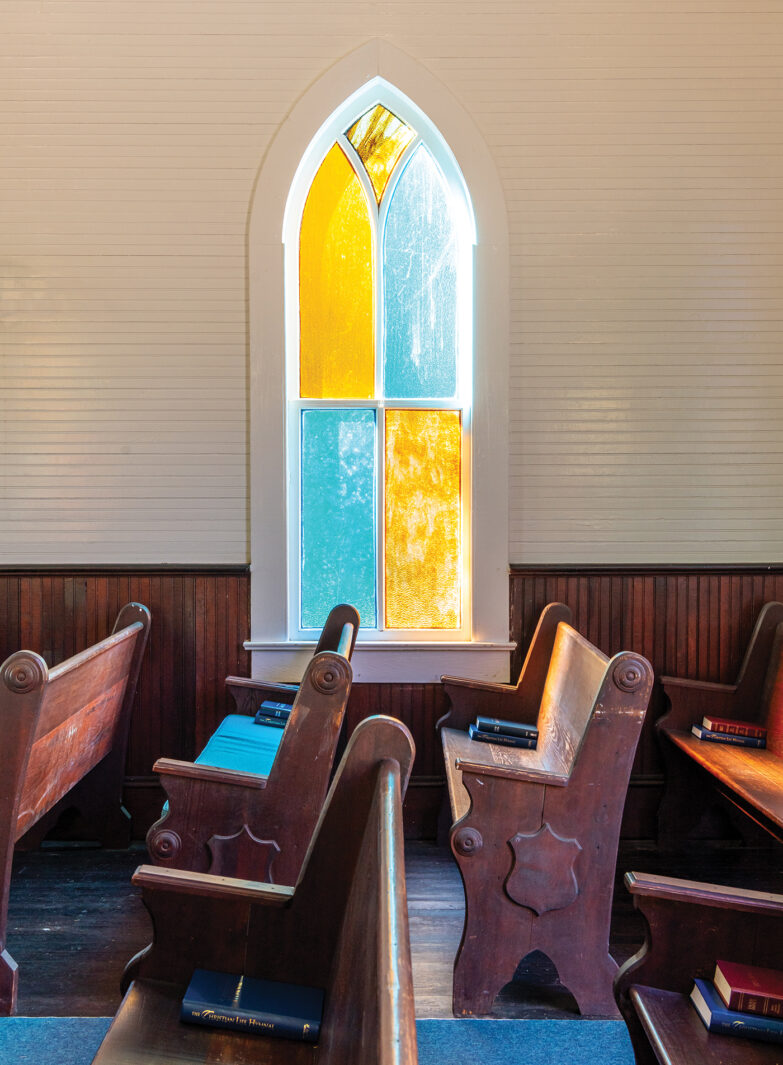
Latham Methodist Church This one-room sanctuary has its original pews, walls, ceilings and stained-glass window panes.
Wild country is yoked with hardship, more so during the age of steamboats and stagecoaches than it is now. Cougars threatened livestock and people alike, parents buried their young children and yellow fever and dysentery jeopardized small communities. One settler set a trap in a 16-foot-wide pit to contend with packs of wolves, and another appointed himself as the area’s official tick inspector when livestock were plagued by Texas Fever Ticks, developing his own concoction for a medicated pool where farmers would bathe their cows.
For what the residents of the Delta withstood from the elements, they were not spared the deeds of men. Vivid written accounts of their lives describe brawls, ambushes, armed robberies and war-born ruin. As one homesteader journaled, men with liquor in their blood and gambling money in their pocket “whipped out their pistols for little or no insult.”
As fraught as life could be in the backcountry, the Delta Christians found serenity in piety and goodwill. People across denominations would orchestrate “house raisings” to build homes for newlyweds and for families whose homes burned from kerosene lamps. “Log rollings” were community affairs held to help farmers clear land for planting crops. Camp meetings were liturgical picnics where communion with God was dictated not by time but by the congregation’s divine connection, lasting until each member had lifted their last prayer. Circuit-riding preachers traveled between sites of salvation to save souls like one Stocktonian who renounced tobacco and his fondness for English’s foulest four-letter words when he found religion — a revelation that he claimed “changed the color of his spit.”
Pastoral parishioners anchored devotion to one another through their devotion to their faith. The wealthy employed the poor, families loved the lonely and the nourished fed the hungry. God has always shepherded them, and the historic churches along the Mobile-Tensaw River Delta are testaments to His presence there.
Left Montgomery Hill Baptist Church is considered a pristine example of Simple Greek Revival architecture. Right The three rows of original pews in the sanctuary were for white congregation members, while slaves were relegated to benches in the slave loft.
Montgomery Hill Baptist Church
Religion was the bedrock of rural life for the Baptists of Montgomery Hill before they built their church. A circuit-riding preacher named Lorenzo Dow organized the earliest iteration of the church under a brush arbor in 1803. The congregation moved into the Holly Creek Union Church that they shared with the local Methodists a few years later, but their numbers were strong enough to justify building their own church by the 1850s. A man named John Blake was commissioned to construct the simple Greek Revival chapel on donated land in 1851 for $1,450, and services began in the completed building in 1855.
Reverend A.J. Lambert presided over the first congregation of 89 agriculturalists, their families and their slaves, and their numbers grew until 1865 when the Civil War ended and former slaves who were no longer confined to the Montgomery Hill’s slave loft left to establish their own churches. Despite their diminished numbers, many notable figures passed through the doors of the sanctuary, including doctors, nurses, teachers, busin-essmen and one suspected murderer who hopefully found God in the month he took refuge in the church’s attic. Regardless of any penance, it wouldn’t have been proper for him to be buried alongside the upstanding congregation members in the cemetery beside the chapel.
Little has changed since Alabama’s oldest continuously- operating church held its first baptisms, revivals, weddings and funerals. Though the current congregation can now read the Holy Scriptures under electric lights, they enter through the same wooden doors, sit in the same pews and worship at the same altar as their ancestors did. They’ve maintained the original hardware and light fixtures, and they’ve preserved Pastor Lambert’s time-worn Bible in a glass case at the back of the sanctuary. The history that lives in the walls of the chapel is palpable. It draws thickly into the lungs, echoes in silence and hazes the light that pierces through the shuttered windows.
Latham Methodist Church’s stained-glass window panes were packed in sawdust and shipped in wooden crates to the church by riverboat.
Latham Methodist Church
The Methodists of Red Hill communed with God in a log cabin in 1852. It was a fine-enough sanctuary. The fence around the building kept the goats and cows from interrupting services, candles on shelves radiated enough light to read the Bible during night services and the wooden corral in Red Hill Creek was serviceable for full-immersion baptisms. Services were simple. The Mount Pleasant Circuit’s presiding elder would arrive by horse and buggy every few weekends and stay with congregants in their homes. Morning and evening sermons began with prayer followed by hymns sung a cappella. The austerity of the homilies made fellowship with the Lord all the richer.
The Red Hill Methodists became the Latham Methodists in 1878 when the town changed its name in honor of their new post office and their first postmistress’s father-in-law, Latham Cooper. In 1886, the congregation erected a frame church that served as a school on the weekdays, but it was destroyed shortly thereafter. The Latham Methodists were resilient, determined people, and they built a new church in 1906 using virgin pine hauled to their new site by ox teams and a two-mule wagon. The stained-glass window panes arrived from Mobile by riverboat, and the ladies of the church raised enough funds to purchase church pews and a bell. The remaining costs totaling $1,500 were paid by local Christians from all denominations.
The one-room Vernacular Gothic Revival chapel has changed little since its construction, but the congregation has changed the lives of many over the last century. Members traveled to other communities to host Sunday School, helped organize other churches and gave young men one acre of farmland during the Great Depression for them to grow produce to pay for missions.
Latham Methodist Church parishioners remain stewards of their community today, their spirits for charity steeled from the same pulpit that inspirited those that came before them.
Though Montpelier Methodist church was moved from its original location to Baldwin County Bicentennial Park in 2013, it maintains its original light fixtures, pews, pulpit and stained-glass windows.
Montpelier Methodist Church
The chapel with technicolor windows in Baldwin County Bicentennial Park was a gift from God and General Andrew Jackson. Following the Fort Mims Massacre, the Earle family allowed Jackson’s wife to stay with them at the Montpelier plantation for three months during the general’s Pensacola Campaign. Jackson granted a sizeable tract of land to the Earles to express his gratitude for their hospitality, and he returned to enjoy his gift for five months around the time of his resignation as Florida’s governor in 1821. Though he twice stayed at the Earles’ home, he would pass away before he could worship with them in the house of the Lord.
The Earles built Montpelier Chapel on their plantation of the same name in 1895 and shared their pews with a few other close friends. A minister traveled by horseback from Stockton once a month to minister to the diminutive congregation, who thanked him for his services by having him to their homes for after-church lunch.
Montpelier Chapel became Blacksher Chapel in the early 1900s in honor of the region’s newly-established post office. The Earles attended services there until the 1970s, and the shuttered little church sat forsaken in a pasture that eventually became a scrapyard. Its abandonment lent itself to the chapel’s preservation. The church was donated by the Earle family and moved to Stockton’s Bicentennial Park in 2013 with its original pews, fixtures, hardware and pulpit. Its Christian name was restored, and God still bears witness to the wedding vows made at the altar.
Left The Stockton Methodist Church sanctuary in golden light. Right The exterior of Stockton Methodist Church is inspired by Neoclassical design.
Stockton Methodist Church
The Methodists of Stockton praised the Lord alongside the Presbyterians at a union church before they officially organized and built their own chapel in 1885, which was destroyed by a fire in 1898. Though the congregation suffered the loss of their house of worship, the reverend suffered the loss of his home when the fire spread to the parsonage. The service-minded members of the church were prepared to support their preacher, one of whom offered the pastor a room he had already built for itinerant preachers who passed through town. God’s Word could be studied anywhere so long as the flock had a shepherd to lead them.
The reverend found a new home before the congregation did. It wasn’t until a hurricane destroyed the town’s schoolhouse in 1926 that the Lord provided them with the land and materials to rebuild their sanctuary. They purchased the school property for $350 and used salvaged timber from the schoolhouse and a memorial window from the first church to build the Classical-Revival-inspired chapel that was dedicated in 1929. The congregation embraced their new beginnings by returning to their past. Because of their kinship with the Stockton Presbyterians from their union-church days, they shared their new building with their Calvinist brethren until 1954. The congregations now worship next to each other on adjoining lots and wave to each other as they enter their own sanctuaries.
Was and Is to Come
In a modern world afflicted by detachment and disconnection, the churches of the Delta abide, their congregations attending as faithfully now as they did a century ago. Age-old hymns are still played on pianos nearly as antique as the songs themselves. Familiar prayers are lifted on behalf of the ill and weary, and ancient doxologies are recited before every sermon. The keepers of the churches’ histories pour into young couples and their children who will sustain their heritage. Their future lies in what has always been. Their faith endures; His promises remain.

